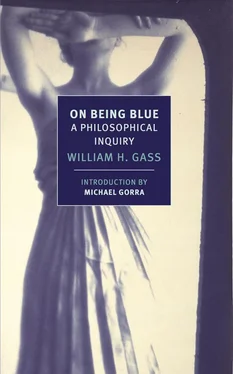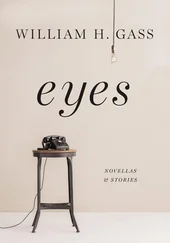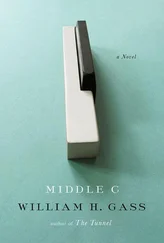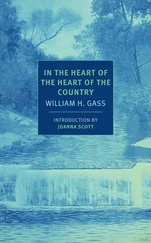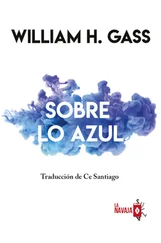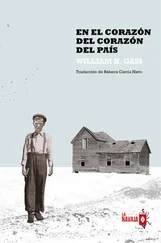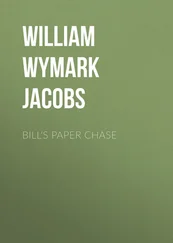Pigmy Blue,
Common Blue,
or Spring Azure, whose larvae secrete what the ants call ‘honeydew,’ the Western Tailed Blue,
Square-spotted Blue,
Acmon Blue,
Orange-bordered or Melissa Blue, which has two broods,
Reakirt’s Blue, which feeds on mesquite, the Silvery Blue,
Sonora Blue,
Saepiolus Blue,
Marine Blue,
whose worms chew upon locoweed and the blossoms of the wisteria, or the blues of the great poems…
ix
And the color, the overcast blue
Of the air, in which the blue guitar
Is a form, described but difficult,
And I am merely a shadow hunched
Above the arrowy, still strings,
The maker of a thing yet to be made;
The color like a thought that grows
Out of a mood, the tragic robe
Of the actor, half his gesture, half
His speech, the dress of his meaning, silk
Sodden with his melancholy words,
The weather of his stage, himself.
(Wallace Stevens: ‘The Man with the Blue Guitar’)
Or the emblematic blues, the color in which Joyce bound Ulysses, its title like a chain of white islands, petals shaken on a Greek sea, he thought, and the heraldic blues, the celebrational and symbolic…
Gargantua’s colors were white and blue…. By these colors, his father wished to signify that the lad was a heavenly joy to him. White expresses joy, pleasure, delight and rejoicing; blue denotes things celestial.
I realize quite well that, as you read these words, you are laughing at the old toper, for you believe this symbolic use of colors to be crude and extravagant. White, you say, stands for faith, and blue for strength. But without getting excited, losing your temper, flying into a rage or working yourself into a tongue-parched passion — the weather is dangerous — tell me one thing!… What moves, impels or induces you to believe what you do? Who told you that white means faith, and blue strength?
‘A shoddy book,’ you reply, ‘sold by peddlers in remote mountain hamlets and by weatherbeaten hawkers God knows where. Its title? In Praise of Colors.’
or the blues we rebreathe, always for the same reason: because the word in each case finds its place within a system so supremely organized it cannot be improved upon — what we would not replace and cannot change. Of how many racy tales or hairy photos can that be said?
So sentences are copied, constructed, or created; they are uttered, mentioned, or used; each says, means, implies, reveals, connects; each titillates, invites, conceals, suggests; and each is eventually either consumed or conserved; nevertheless, the lines in Stevens or the sentences of Joyce and James, pressed by one another into being as though the words before and the words after were those reverent hands both Rilke and Rodin have celebrated, clay calling to clay like mating birds, concept responding to concept the way passionate flesh congests, every note a nipple on the breast, at once a triumphant pinnacle and perfect conclusion, like pelted water, I think I said, yet at the same time only another anonymous cell, and selfless in its service to the shaping skin as lost forgotten matter is in all walls; these lines, these sentences, are not quite uttered, not quite mentioned, peculiarly employed, strangely listed, oddly used, as though a shadow were the leaves, limbs, trunk of a new tree, and the shade itself were thrust like a dark torch into the grassy air in the same slow and forceful way as its own roots, entering the earth, roughen the darkness there till all its freshly shattered facets shine against themselves as teeth do in the clenched jaw; for Rabelais was wrong, blue is the color of the mind in borrow of the body; it is the color consciousness becomes when caressed; it is the dark inside of sentences, sentences which follow their own turnings inward out of sight like the whorls of a shell, and which we follow warily, as Alice after that rabbit, nervous and white, till suddenly — there! climbing down clauses and passing through ‘and’ as it opens — there — there — we’re here!… in time for tea and tantrums; such are the sentences we should like to love — the ones which love us and themselves as well — incestuous sentences — sentences which make an imaginary speaker speak the imagination loudly to the reading eye; that have a kind of orality transmogrified: not the tongue touching the genital tip, but the idea of the tongue, the thought of the tongue, word-wet to part-wet, public mouth to private, seed to speech, and speech… ah! after exclamations, groans, with order gone, disorder on the way, we subside through sentences like these, the risk of senselessness like this, to float like leaves on the restful surface of that world of words to come, and there, in peace, patiently to dream of the sensuous, imagined, and mindful Sublime.
• • •
Half-breeds belong to the blue squadron. Sometimes they are called ‘blue skins,’ as Protestants once were. Blue Boy is the popular title of a painting by Gainsborough, the name of a prize hog in State Fair, and the abscess from a venereal disease. Under the vilifying gaze of fluorescent light, the heads of pimples turn blue, as do the rings around the eyes, and the lips grow cold. Although the form, ‘blueness,’ signifies the quality of being blue in any sense, it usually refers only to indecency: les horreurs, les bêtises, les gueulées . Will it profit us to wonder why? Jackson Pollock painted Blue Poles, the name of any magnet’s southern dart. Earlier he’d covered a canvas he labeled The Blue Unconscious . Here the color is sparingly used. A group of Germans got itself called the Blaue Reiter, and Piero della Francesca did indeed make the Virgin’s mantle blue in his Annunciation … in his Nativity, too. Nor did the Lorenzettis neglect her, Giotto neither, though he colored his pit-of-hell devils blue as a soul dismantled. Contending that art is a product of pain, Picasso passed through such a period, painting The Blue Room, Woman in Blue, and many others: stem-like bodies on which long faces gather like solidifying smoke.
‘For our blues,’ Hoogstraten says, ‘we have English, German, and Haarlem ashes, smalts, blue lakes, indigo, and the invaluable ultramarine.’ It is of course the sky. It is the sky’s pale deep endlessness, sometimes so intense at noon the brightness flakes like a fresco. Then at dusk, it is the way the color sinks among us, not like dew but settling dust or poisonous exhaust from all the life burned up while we were busy being other than ourselves. For our blues we have the azures and ceruleans, lapis lazulis, the light and dusty, the powder blues, the deeps: royal, sapphire, navy, and marine; there are the pavonian or peacock blues, the reddish blues: damson, madder and cadet, hyacinth, periwinkle, wine, wisteria and mulberry; there are the sloe blues, a bit purpled or violescent, and then the green blues, too: robin’s egg and eggshell blue, beryl, cobalt, glaucous blue, jouvence, turquoise, aquamarine. A nice light blue can be prepared from silver, and when burned, Prussian blue furnishes a very fine and durable brown. For our blues we have those named for nations, cities, regions: French blue, which is an artificial ultramarine, Italian, Prussian, Swiss and Brunswick blues, Chinese blue, a pigment which has a peculiar reddish-bronze cast when in lump-form and dry, in contrast to China blue which is a simple soluble dye; we have Indian blue, an indigo, Hungarian, a cobalt, the blues of Parma and Saxony, Paris, Berlin, and Dresden, those of Bremen and Antwerp, the ancient blues of Armenia and Alexandria, the latter made of copper and lime and sometimes called Egyptian, the blue of the Nile, the blue of the blue sand potters use. Are there so many states of mind and shades of feeling? In a dress riddled with polka dots, Colette, arthritic and frizzy in her final photographs, sits with the profile of Cocteau, le fanal bleu, her papers and her pain. And for our blues we have those named for persons, processes, and earths: Hortense, Croupier, Blackley blue and Chemic, Imperial or spirit-blue, Raymond or Napoleon blue, Night blue or Victoria, Leitch’s blue, Schweinfurth’s or Reboulleau’s blue, Monthier’s blue, which uses ammonia, Elberfeld, Eschel, Gentiana blue, Gold blue, Guernsey, Guimet, Humboldt and the coal-tar colors, Aniline, Alkali, Anthracene blue, Alizarin blue, paste blue, vat blue, fast blue, the fluorescent resorcinol blues, milori, vitriol, blue verditer, slate and steel blue, all the grays, gun-metal, asbestos, and then the bluish shades of verdigris appearing subtly in the same way that our attitudes slowly acetify our bodies. Fra Angelico, that sweet man, did not ignore the Virgin either, though her mantle, alas, is never blue, but sometimes lavender or even green. ‘Green’ is another name, though now forgotten, long unused, for things obscene.
Читать дальше
